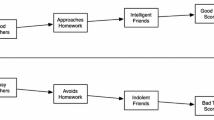Abstract
A hierarchical longitudinal path model is described for analysis of twin and sibling data. The model combines multivariate and longitudinal methodologies for assessment of continuity and change in the relationships among characters over time. Additionally, the model permits assessment of shared and independent etiologies for groups of measures at single and multiple occasions. The procedure is illustrated by application to specific cognitive ability data from 103 adopted and 109 nonadopted sibling pairs at ages 3, 4, 7, and 9 years, and 50 pairs of monozygotic and dizygotic twins at ages 3 and 4 years. The results suggest that much of the observed continuity in general intelligence measures is attributable to genetic influences common to specific abilities and indicate differential etiologies for specific abilities at different occasions in childhood.
Similar content being viewed by others
References
Anderson, T. W. (1960). Some stochastic process models for intelligence test scores. In Arrow, K., Karlin, S., and Suppes, P. (eds.),Mathematical Methods in the Social Sciences, Stanford University Press, Stanford, CA, pp. 205–220.
Boomsma, D. I., and Molenaar, P. C. M. (1987). The genetic analysis of repeated measures.Behav. Genet. 17:111–123.
Burt, C. (1949). Alternative methods of factor analysis and their relations to Pearson's method of principal axes.Br. J. Psychol. Stat. 2:98–121.
Cardon, L. R. (1992).Multivariate Path Analysis of Specific Cognitive Abilities in the Colorado Adoption Project, Unpublished doctoral dissertation, University of Colorado, Boulder.
Cardon, L. R., Corley, R. P., DeFries, J. C., and Plomin, R. (1992a). Factorial validation of a telephone test battery of specific cognitive abilities.Personal. Indiv. Differ. 13:1047–1050.
Cardon, L. R., Fulker, D. W., DeFries, J. C., and Plomin, R. (1992b). Multivariate genetic analysis of specific cognitive abilities in the Colorado Adoption Project at age 7.Intelligence 16:383–399.
Cyphers, L., Fulker, D. W., Plomin, R. and DeFries, J. C. (1989). Cognitive abilities in the early school years: No effects of shared environment between parents and offspring.Intelligence 13:369–384.
DeFries, J. C., Plomin, R., Vandenberg, S. G., and Kuse, A. R. (1981). Parent-offspring resemblance for cognitive abilities in the Colorado Adoption Project: Biological, adoptive, and control parents and one-year-old children.Intelligence 5:245–277.
Eaves, L. J., Long, J., and Heath, A. C. (1986). A theory of developmental change in quantitative phenotypes applied to cognitive development.Behav. Genet. 16:143–162.
Falconer, D. S. (1981).Introduction to Quantitative Genetics, 2nd ed., Longman Group, New York.
Garrett, H. E. (1946). A developmental theory of intelligence.Am. Psychol. 1:372–378.
Guttman, L. (1954). A new approach to factor analysis: The radex. In Lazarsfeld, P. F., (ed.),Mathematical Thinking in the Social Sciences, Free Press, Glencoe, IL, pp. 258–349.
Hewitt, J. K., Eaves, L. J., Neale, M. C., and Meyer, J. M. (1988). Resolving causes of developmental continuity or “tracking.” I. Longitudinal twin studies during growth.Behav. Genet. 18:133–151.
Humphreys, L. G. (1985). General intelligence: An integration of factor, test, and simplex theory. In Wolman, B. B. (ed.),Handbook of Intelligence: Theories, Measurement, and Applications, Wiley, New York, pp. 201–244.
Humphreys, L. G. (1989). The first factor extracted is an unreliable estimate of “g”: The case of discrimination reaction time.Intelligence 13:183–197.
Jöreskog, K. G., and Sörbom, D. (1989).LISREL 7: A Guide to the Program and Applications, 2nd ed., SPSS, Chicago.
Kendler, K. S., Heath, A. C., Martin, N. G., and Eaves, L. J. (1987). Symptoms of anxiety and symptoms of depression: Same genes, different environments?Arch. Gen. Psychiat. 44:451–457.
Kent, J., and Plomin, R. (1987). Testing specific cognitive abilities by telephone and mail.Intelligence 11:391–400.
Lange, K., Westlake, J., and Spence, M. A. (1976). Extensions to pedigree analysis. III. Variance components by the scoring method.Ann. Hum. Genet. 39:485–491.
McArdle, J. J. (1986). Latent variable growth within behavior genetic models.Behav. Genet. 16:163–200.
McArdle, J. J., and Goldsmith, H. H. (1990). Alternative common-factor models for multivariate biometric analyses.Behav. Genet. 20:569–608.
NAG (1990).The NAG Fortran Library Manual, Mark 14, Numerical Algorithms Group, Oxford.
Neale, M. C., and Cardon, L. R. (1992).Methodology for Genetic Studies of Twins and Families, Kluwer Academic, Boston.
Phillips, K., and Fulker, D. W. (1989). Quantitative genetic analysis of longitudinal trends in adoption designs with application to IQ in the Colorado Adoption Project.Behav. Genet. 19:621–658.
Plomin, R., DeFries, J. C., and Fulker, D. W. (1988).Nature and Nurture During Infancy and Early Childhood, Cambridge University Press, New York.
Rice, T., Corley, R., Fulker, D. W., and Plomin, R. (1986). The development and validation of a test battery measuring specific cognitive abilities in four-year-old children.Educ. Psychol. Measure. 46:699–708.
Scarr, S. (1989). Protecting general intelligence. In Linn, R. L. (ed.),Intelligence: Measurement, Theory, and Public Policy, University of Illinois Press, Chicago, pp. 74–118.
Schmid, J., and Leiman, J. (1957). The development of hierarchical factor solutions.Psychometrika 22:53–61.
Singer, S., Corley, R., Guiffrida, C., and Plomin, R. (1984). The development and validation of a test battery to measure differentiated cognitive abilities in three-year-old children.Educ. Psychol. Measure. 49:703–713.
Spearman, C. (1904). General intelligence objectively determined and measured.Am. J. Psychol. 15:201–293.
Thurstone, L. L. (1938).Primary Mental Abilities, University of Chicago, Chicago.
Vernon, P. E. (1979).Intelligence: Heredity and Environment, W. H. Freeman, San Francisco.
Wechsler, D. (1974).Manual for the Wechsler Intelligence Scale for Children-Revised, Psychological Corp., New York.
Author information
Authors and Affiliations
Rights and permissions
About this article
Cite this article
Cardon, L.R., Fulker, D.W. A model of developmental change in hierarchical phenotypes with application to specific cognitive abilities. Behav Genet 24, 1–16 (1994). https://doi.org/10.1007/BF01067924
Received:
Accepted:
Issue Date:
DOI: https://doi.org/10.1007/BF01067924




